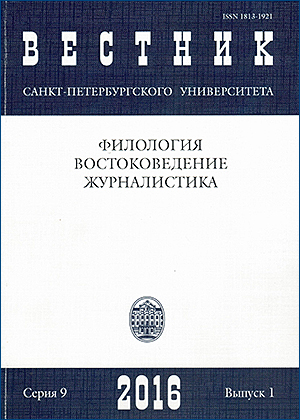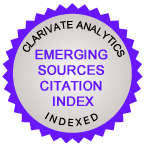Operating Norms Governing Translation on the Basis of Russian-Chinese Corpora — with a Case of чтобы Clauses in Russian
DOI:
https://doi.org/10.21638/11701/spbu09.2016.111Abstract
On the basis of a Russian-Chinese corpus (with a focus on academic texts of social sciences and the humanities), this paper explores operational norms governing translation of чтобы clauses that are typical to the Russian language. It concludes that: 1) there are three norms in their translation into Chinese: explicitation-implicitation norms, simplification-complication norms and domesticationforeignisation norms; 2) both explicitation and implicitation norms stand out in the translation of чтобы clauses into Chinese because formalisation disparities between Russian and Chinese are more striking than those between English and Chinese; 3) as for чтобы clauses, there are more simple sentences in the target texts (TT) than in the source texts (ST); there are more complex sentences in TT than in non-translational texts (NTT) because complex sentences are prevalent in Russian while simple sentences are common in Chinese; and 4) due to the structural features of the Russian language, foreignisation norms are more obvious than domestication norms respectively in the translation of чтобы clauses into Chinese.
Downloads
References
Библиография:
Baker M. Corpus Linguistics and Translation Studies: Implications and Applications. Text and Technology: in Honor of John Sinclair. Eds M.Baker, G.Francis, E.Tognini-Bonellis. Amsterdam, John Benjamins Publ., 1993.
Baker M. Routledge Encyclopedia of Translation Studies. London, New Yorker, Routledge, 2001. Chesterman A. Memes of Translation. The Spread of Ideas in Translation Theory. Amsterdam, Philadelphia, Benjamins, 1997.
Hermans T. Translation in Systems: Descriptive and System-oriented Approaches Explained. Manchester, St. Jerome Publishing, 1999.
Hu Kai-bao. Syntactic Operational Norms of Press Conference Interpreting (Chinese-English). Foreign Language Teaching and Research, 2012, vol. 5, pp. 738–750.
Hu Xiao-yao. A Corpus-based Study on the Translational Norms of Contemporary Chinese Fiction. Shanghai, East China Normal University, 2006.
Hu Xiao-yao. Corpus-based Translation Study on Modern Chinese. Beijing, Foreign Language Press, 2008.
Huang Li-bo, Zhu Zhi-yu. Corpus-based Translatology: Research Focus and Methodology. Foreign Languages in China, 2012, vol. 6, pp. 28–35.
Huang Li-bo. A Corpus-based Research on Translation Universals in Chinese-English. English-Chinese Translation. Shanghai, Fudan University Press, 2007.
Palumbo G. Key Terms in Translation Studies. London, Continuum International Publishing Group, 2009.
Qin Hong-wu. Load Capacity of Constructions in Translational Chinese: A Multi-version Corpus-based Study. Journal of Foreign Languages, 2010, vol. 4, pp. 73–80.
Tang Fang, Li De-chao. Explicitation in Chinese-English Consecutive Interpretation-A Comparative Study of Professional and Student Interpreter. Foreign Language Teaching and Research, 2013, vol. 3б pp. 442– 453.
Tao Yuan. On Some Transitional Features of Classification of Russian Complex Sentences. Shandong Foreign Language Teaching Journal, 2006, vol. 1, pp. 43–46.
Tao Yuan, Zakharov V. P. The Development and Use of Russian-Chinese Parallel Corpus. Automatic Documentation and Mathematical Linguistics, 2015, vol. 2, pp. 65–75 (in press).
Toury G. In Search of a Theory of Translation. Tel Aviv, The Porter Institute for Poetics and Semiotics, Tel Aviv University, 1980.
Toury G. Descriptive Translation Studies and Beyond. Amsterdam, John Benjamins Publ., 1995.
Wang Ke-fei. A Probe into Corpus-based Translatology. Shanghai, Shanghai Jiaotong University Press, 2012.
Wang Yong-na. Analyses of the Differences Between “Weile” and “Yibian” & SL Acquisition Situation in Overseas Students (Unpublished MA thesis). Guangzhou, Ji Nan University, 2004.
Zhang Hui-sen. A Comprative Study on Russian-Chinese Study. Shanghai, Shanghai Foreign Language Education Press, 2004.
Zhao Shi-ju. Lexical Decisive Function of Meaning on Grammar. Wuhan University Journal (Humanity Sciences), 2008, vol. 2, pp. 173–179.
Kozhina M. N. Stilistika russkogo iazyka [Stylistics of the Russian language]. Moscow, Prosveshchenie Publ., 1983. (In Russian)
Bibliography:
Baker, M. Corpus Linguistics and Translation Studies: Implications and Applications. Text and Technology: in Honor of John Sinclair. Eds M.Baker, G.Francis, E.Tognini-Bonellis. Amsterdam, John Benjamins Publ., 1993.
Baker, M. Routledge Encyclopedia of Translation Studies. London, New Yorker, Routledge, 2001.
Chesterman, A. Memes of Translation. The Spread of Ideas in Translation Theory. Amsterdam, Philadelphia, Benjamins, 1997.
Hermans, T. Translation in Systems: Descriptive and System-oriented Approaches Explained. Manchester, St. Jerome Publishing, 1999.
Hu, Kai-bao. Syntactic Operational Norms of Press Conference Interpreting (Chinese-English). Foreign Language Teaching and Research, 2012, vol. 5, pp. 738–750.
Hu, Xiao-yao. A Corpus-based Study on the Translational Norms of Contemporary Chinese Fiction. Shanghai, East China Normal Univ., 2006.
Hu, Xiao-yao. Corpus-based Translation Study on Modern Chinese. Beijing, Foreign Language Press, 2008.
Huang, Li-bo, Zhu, Zhi-yu. Corpus-based Translatology: Research Focus and Methodology. Foreign Languages in China, 2012, vol. 6, pp. 28–35.
Huang, Li-bo. A Corpus-based Research on Translation Universals in Chinese-English. English-Chinese Translation. Shanghai, Fudan Univ. Press, 2007.
Palumbo, G. Key Terms in Translation Studies. London, Continuum International Publishing Group, 2009.
Qin, Hong-wu. Load Capacity of Constructions in Translational Chinese: A Multi-version Corpus-based Study. Journal of Foreign Languages, 2010, vol. 4, pp. 73–80.
Tang Fang, Li, De-chao. Explicitation in Chinese-English Consecutive Interpretation-A Comparative Study of Professional and Student Interpreter. Foreign Language Teaching and Research, 2013, vol. 3б pp. 442– 453.
Tao, Yuan. On Some Transitional Features of Classification of Russian Complex Sentences. Shandong Foreign Language Teaching Journal, 2006, vol. 1, pp. 43–46.
Tao, Yuan, Zakharov, V. P. The Development and Use of Russian-Chinese Parallel Corpus. Automatic Documentation and Mathematical Linguistics, 2015, vol. 2, pp. 65–75 (in progress).
Toury, G. In Search of a Theory of Translation. Tel Aviv, The Porter Institute for Poetics and Semiotics, Tel Aviv Univ., 1980.
Toury, G. Descriptive Translation Studies and Beyond. Amsterdam, John Benjamins Publ., 1995.
Wang, Ke-fei. A Probe into Corpus-based Translatology. Shanghai, Shanghai Jiaotong Univ. Press, 2012.
Wang, Yong-na. Analyses of the Differences Between “Weile” and “Yibian” & SL Acquisition Situation in Overseas Students (Unpublished MA thesis). Guangzhou, Ji Nan Univ., 2004.
Zhang, Hui-sen. A Comprative Study on Russian-Chinese Study. Shanghai, Shanghai Foreign Language Education Press, 2004. (in Russian)
Zhao, Shi-ju. Lexical Decisive Function of Meaning on Grammar. Wuhan University Journal (Humanity Sciences), 2008, vol. 2, pp. 173–179.
Kozhina, M. N. Stilistika russkogo iazyka [Stylistics of the Russian language]. Moscow, Prosveshchenie Publ., 1983. (In Russian)
Downloads
Published
How to Cite
Issue
Section
License
Articles of "Vestnik of Saint Petersburg University. Language and Literature" are open access distributed under the terms of the License Agreement with Saint Petersburg State University, which permits to the authors unrestricted distribution and self-archiving free of charge.






